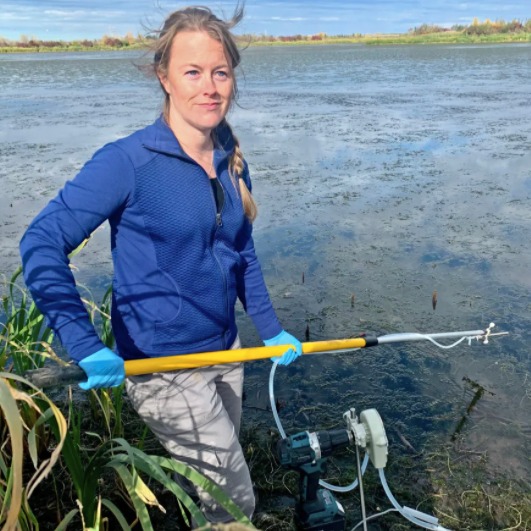
eDNA Amphibian Pilot
Categories: DNA
Status: Completed
About the Project
In the spring of 2020, we initiated a pilot project with Innotech Alberta to explore the effectiveness of environmental DNA (eDNA) technology for monitoring amphibians in wetland habitats. The objectives of the project were to:
- Develop field protocols to collect amphibian DNA in open water wetlands.
- Develop and test primers for target amphibian species.
- Compare the detection ability of eDNA to the current monitoring methods employed by the ABMI (Autonomous Recording Units).
eDNA refers to DNA fragments that are shed by organisms in the environment, and to the group of technologies and methodologies used to detect this DNA in environmental samples and attribute it to specific organisms. The technique can detect species without having to collect or observe specimens. This can reduce field time and the impact of field activities on target species and habitats. eDNA is also well suited to detecting rare and elusive species and to all life stages of a species (e.g., egg, larvae, adult).
At four wetlands in the Edmonton area, we surveyed amphibian presence by collecting eDNA and sound recordings throughout the summer. Our eDNA collection methods were based on those originally developed by Brian Eaton’s team at InnoTech Alberta. The eDNA was collected by filtering 3-liter water samples at three locations. One autonomous recording unit (ARU) collected sound recordings at the site periodically throughout every day. Amphibians were identified by their calls from a random selection of these recordings.

Photo: Brandon Allen
Project Impact
The results indicated that both monitoring methods (eDNA and ARUs) had advantages depending on the target species. Tiger Salamanders were only detected by eDNA at two sites. This result makes sense because Tiger Salamanders don't broadcast calls. Additionally, a Western Toad was detected at one site by the ARU but not eDNA. The project revealed that eDNA is a valuable tool in the monitoring tool box and that the efficiency of using either method depends on species-specific life history and site conditions. Due to the nature of eDNA sampling (requires less exhaustive surveys), the difficulties in identifying certain species, and our requirement for reliable trend data, eDNA may serve to complement or modernize some of our current sampling protocols.
eDNA is a new and promising method with the potential to increase the efficiency of monitoring a wide array of taxa. We are currently exploring the possibility of incorporating DNA monitoring methods for macroinvertebrates and vascular plants.
This project will help to expand our understanding of the cumulative effects of intensive agriculture and climate change in aquatic ecosystems while expanding the use of new techniques in environmental genomics to support large-scale monitoring of aquatic invertebrates and plants.
The Peltigera project aims to expand our understanding of Peltigera lichen diversity in Alberta through genetic markers. Building on the research done by global Peltigera experts, we hope to use genetic data to both verify our identifications and detect new species to the province.
In 2017, we undertook a 10-year science and program review that evaluated the degree to which we delivered on our scientific goals and objectives during the first 10 years of operation.



